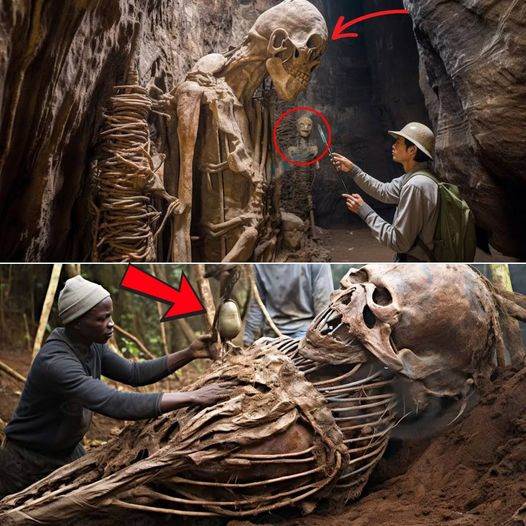
Unveiling Ancient Wonders: Giant Skeletons Found Below the Grand CanyonThe Grand Canyon is already known to be a place of stunning natural beauty and wonder, drawing millions of visitors each year to marvel at its vast, rugged landscape and the mighty Colorado River carving through it. However, recent discoveries deep below the surface of the canyon have revealed an even more incredible and mysterious aspect to this iconic location.
In a surprising turn of events, a team of archaeologists exploring the depths of the Grand Canyon stumbled upon a series of caverns that led to a stunning discovery – the remains of giant humanoid skeletons.
While initial reports were met with skepticism and doubt, further investigation and analysis have confirmed the authenticity of these ancient wonders, sparking intense interest and debate among researchers and the public alike.
The discovery of giant skeletons below the Grand Canyon has excited the imagination and curiosity of many, raising countless questions about the origin and history of these enigmatic beings. Could these colossal remains be evidence of a lost civilization or an entirely different branch of humanity? What do they tell us about the ancient world and the mysteries that still remain hidden beneath the Earth's surface? As we delve deeper into this fascinating find, we will explore the implications and potential impact of this discovery on our understanding of human history and the secrets that lie buried beneath the Grand Canyon.
The Initial DiscoveryThe journey to uncover the truth behind the giant skeletons below the Grand Canyon began with a team of archaeologists and explorers embarking on a daring expedition to delve into the depths of the canyon, guided by a sense of adventure and a quest for discovery. What they found far exceeded their expectations, as they stumbled upon a series of hidden caverns that seemed to have remained undisturbed for centuries.
As they ventured deeper into these caverns, the team made a startling discovery – a collection of skeletal remains, unlike anything they had ever seen before. These remains were strikingly large, with bones that dwarfed those of the average human being.
The implications of such a find were monumental, raising questions about the possibility of an ancient race of giants inhabiting the region in ages past.
Initial skepticism and speculation surrounded the discovery, with some dismissing the findings as a mere fabrication or hoax. However, careful analysis and examination of the skeletal remains by experts in the field soon provided evidence supporting their authenticity. The bones were found to be ancient, with carbon dating placing their age at thousands of years, adding a layer of credibility to the extraordinary discovery.
As news of the giant skeletons found below the Grand Canyon spread, it captivated the attention of researchers, historians, and the public at large.
The implications of such a find were profound, as it challenged conventional beliefs about human history and the nature of ancient civilizations. The discovery called for a thorough and comprehensive investigation to unravel the mysteries hidden within the depths of the canyon.
Unraveling the MysteryThe revelation of giant skeletons found below the Grand Canyon raised a multitude of questions that demanded answers. Who were these ancient beings, and what led them to inhabit the region? Did they coexist with early human populations, and what impact did they have on the development of ancient societies? Researchers and experts from diverse fields were eager to explore these questions, diving into the study of the remains and their implications for our understanding of the past.
One of the most pressing questions surrounding the giant skeletons was their origin and the circumstances leading to their presence below the Grand Canyon. Speculation and theories abounded as researchers sought to piece together the puzzle. Some proposed that the skeletons were remnants of a legendary race of giants spoken of in ancient myths and folklore, while others suggested a more practical explanation, such as a subspecies of hominids with unique physical characteristics.
To shed light on the matter, a multidisciplinary approach was adopted to analyze the skeletal remains from various perspectives.
Anthropologists examined the bone structure and morphology to understand the physical characteristics of the individuals, while geneticists sought to extract and analyze DNA samples to determine their lineage and genetic heritage. Archaeologists also scoured the surrounding area for artifacts and cultural remnants that could provide context and insight into the lives of the ancient inhabitants.
The results of these investigations yielded fascinating revelations. The skeletal remains exhibited unique physical traits, including elongated bones and massive skeletal proportions, suggesting that these individuals were indeed of a stature far beyond that of an average human.
The DNA analysis, on the other hand, provided surprising insights, revealing genetic markers and sequences that were distinct from modern human populations, indicating the presence of a distinct lineage among the ancient giants.
Moreover, the surrounding caverns held a treasure trove of artifacts and cultural remnants that provided a glimpse into the daily lives and customs of the ancient inhabitants. Tools, implements, and symbolic artifacts were unearthed, shedding light on the technology, artistry, and cultural practices of the enigmatic giants. These findings added another layer of complexity to the mystery, hinting at a rich and sophisticated civilization that had long been lost to the annals of time.
The implications of these discoveries were profound, painting a picture of a bygone era where giants roamed the Earth, leaving behind traces of their existence that defied conventional understanding. The prospect of a lost civilization of giants inhabiting the region added a new chapter to the story of human history, challenging preconceived notions and opening doors to further exploration and inquiry into the ancient past.
The Impact and ImplicationsThe revelation of giant skeletons found below the Grand Canyon sent shockwaves through the archaeological and scientific community, igniting intense interest and debate about the implications of such an extraordinary discovery.
The implications of this find extended far beyond the realm of academia, capturing the imagination and curiosity of the public at large. The prospect of a lost civilization of giants, shrouded in mystery and wonder, captivated the popular imagination, leading to widespread speculation and excitement.
The impact of this discovery reverberated throughout the fields of archaeology, anthropology, and history, prompting a reevaluation of existing paradigms and models of human evolution and ancient civilizations. The presence of giant skeletal remains challenged the traditional narrative of human history, forcing researchers to reconsider the possibility of alternative branches of the human family tree and the coexistence of different hominid species in the ancient past.
The discovery also sparked a renewed interest in the study of ancient myths, legends, and folklore, as many began to draw connections between the giant skeletons and the larger-than-life figures depicted in traditional stories and narratives. Tales of giants and colossal beings found in cultures around the world took on a new significance, leading some to speculate that the ancient inhabitants of the Grand Canyon may have served as the inspiration for these enduring myths.
Moreover, the implications of the discovery extended beyond the realm of human history, raising questions about the broader impacts of a civilization of giants inhabiting the region.
Did these colossal beings play a role in shaping the natural landscape of the Grand Canyon, leaving behind traces of their presence in the form of ancient structures, earthworks, or other monumental feats of engineering? The potential influence of the giants on the environment and culture of the region added another layer of complexity to the already enigmatic story, suggesting a deep and far-reaching impact on the world around them.
The implications of the giant skeletons found below the Grand Canyon also extended to the realm of popular culture and media, capturing the attention of filmmakers, authors, and artists who were inspired by the fantastical nature of the discovery.
The prospect of a lost civilization of giants provided fertile ground for creative exploration, leading to a wave of fictional works and imaginative interpretations that sought to bring this captivating story to life in new and exciting ways.
However, as with any extraordinary discovery, there were also those who approached the giant skeletons with skepticism and caution, urging thorough and rigorous investigation to confirm the veracity of the findings. Doubts were raised about the possibility of a hoax or misinterpretation of the evidence, calling for further scrutiny and analysis to corroborate the extraordinary claims.
The need for a balanced and critical approach to the discovery was essential to ensure a thorough understanding of its implications and significance.
In the midst of the debate and speculation surrounding the giant skeletons, it became clear that the discovery had ignited a renewed sense of wonder and curiosity about the ancient past, prompting a reexamination of the mysteries that still lay hidden beneath the Earth's surface. The prospect of uncovering new secrets and revelations about the history of our world added a sense of urgency and excitement to the field of archaeology, driving researchers to embark on new explorations and discoveries in the pursuit of knowledge and understanding.
The Future of ExplorationThe discovery of giant skeletons below the Grand Canyon has opened new doors to exploration and discovery, sparking a wave of interest and enthusiasm for uncovering the enigmatic secrets of the ancient world. As researchers and explorers continue to delve into the depths of the canyon and other remote locations, the potential for further extraordinary finds and revelations looms on the horizon, promising a future rich with possibility and discovery.
The field of archaeology, in particular, stands poised to embark on a new chapter of exploration and inquiry, fueled by the tantalizing prospect of uncovering remnants of lost civilizations and extraordinary beings that have long eluded our understanding.
The study of ancient giants and their impact on the world around them has become a focal point of interest, spurring new research initiatives and multidisciplinary collaborations aimed at shedding light on this captivating aspect of human history.
The future of exploration below the Grand Canyon holds the promise of uncovering new evidence and artifacts that may further illuminate the story of the ancient giants and their enigmatic civilization. As technology and methodologies continue to advance, the potential for unparalleled discoveries and insights is greater than ever, offering the possibility of a deeper understanding of the mysteries that have long captivated the human imagination.
Moreover, the impact of the discovery extends beyond the realm of academia, shaping the way in which we perceive the world around us and our place within it. The possibility of a lost civilization of giants challenges our conceptions of the past and the nature of human history, prompting a reevaluation of existing paradigms and assumptions. It reminds us that the mysteries of the ancient world are far from exhausted, offering tantalizing prospects for further exploration and revelation.
As we look to the future of exploration and discovery, the story of the giant skeletons found below the Grand Canyon serves as a powerful reminder of the enduring allure and enigma of the ancient world.
It beckons us to delve deeper into the unknown, to challenge our preconceptions, and to embrace the wonder and curiosity that drives us to uncover the hidden truths that lie buried beneath the Earth's surface. In this spirit of adventure and discovery, we stand on the precipice of a new era of exploration, one that holds the promise of extraordinary revelations and a deeper understanding of the mysteries that have shaped the course of human history.




















